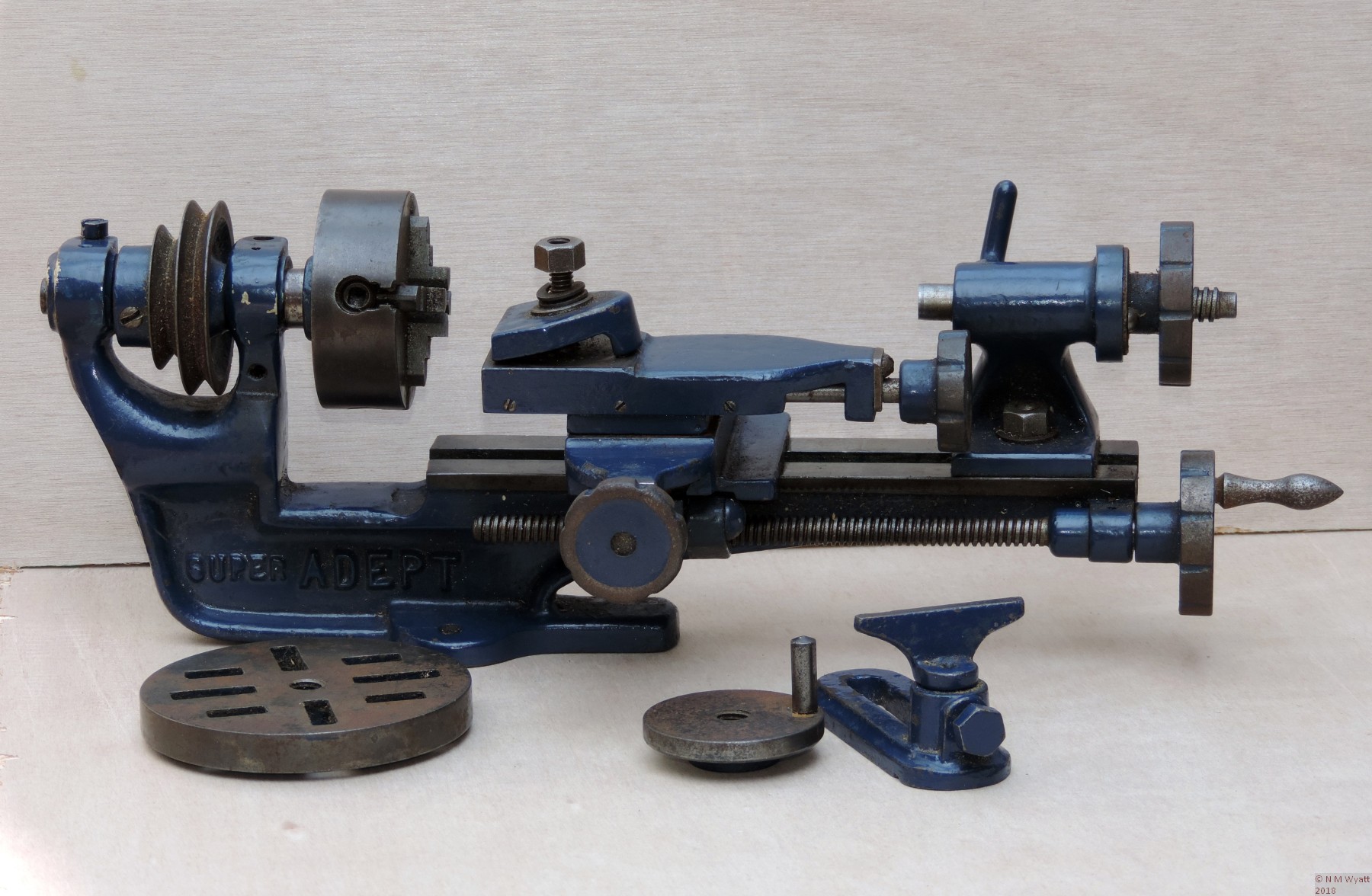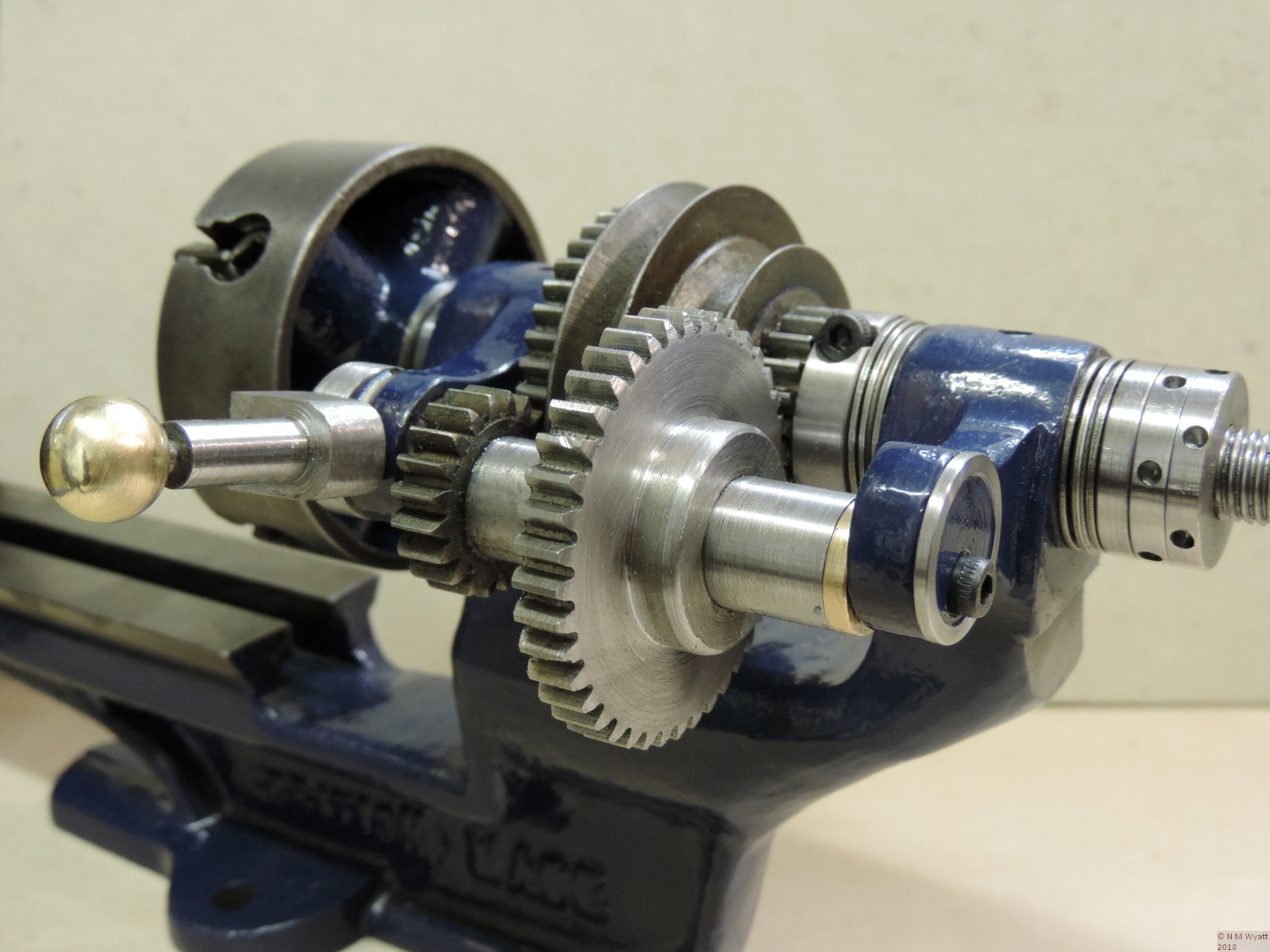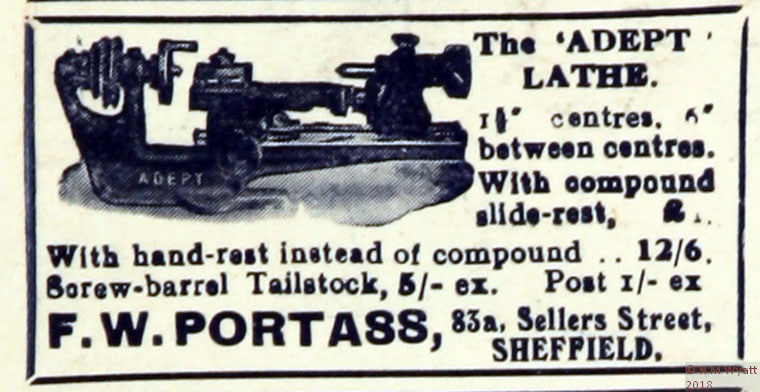If you find this website useful, please check out my books or visit my Amazon Author page. Or even Buy Me a Coffee!
The Adept and Super Adept Register
From the beginnings of the industrial revolution, many of the men (and they were nearly all men even during the Great War) - apprentices, time-served hands and toolmakers who used them wanted to have their own machines at home so thy could make their own projects. However, aside from things like the very basic 'watchmaker's turns', any serious model-making lathe was a considerable investment.
Enter the Adept
In 1931, Fred W. Portass introduced the Adept lathe. This new machine was tiny, barely a foot long, and lacking a moveable saddle. It was about as basic a machine as you could get. But it was working lathe, and despite its tiny mild-steel spindle running in plain cast-iron it proved surprisingly popular. The cost was low - 12/9d or about 64 pence in 1936. Not a casual purchase, but within the reach of many ordinary people. In response to demand the Super Adept was released, benefiting from a proper moveable saddle operated by a leadscrew. The main limitation of the lathe was the spindle with a custom taper far smaller than MT0.
A Super Adept in original, but very worn, condition with various accessories
Ownership of a 'real lathe' had been brought into the reach of even lowly apprentices. With the ability to turn wheels for 2 1/2" gauge locomotives in its modest gap it was ideal for anyone on a budget who wanted to start model engineering. Over a production lifetime of over thirty years hundreds of thousands of Adepts were produced and sold. Model Engineer magazine published many articles on improvements to and accessories for these machines over the years , some of which brought it up to the standard of a genuine precision instrument. Owners of these machines included well known contributors to the magazine like B. Terry Aspin - 'Chuck'. Many of the machines found their way across the British Commonwealth, and even to the USA.
After the Second World War Myford introduced their ML7 followed by the Super 7. Even during the years of austerity, this new machine was a success - and a revolution in small lathe design. But the Myfords were many, many times the price of an Adept or Super adept, so they remained in production, although the design did not change. The 1960s saw a many new small lathes appear, such as the Wizard, Rollo Elf, Flexspeed, Centrix Micro and the German Unimat. As well as being smaller, the Adepts remained relatively crude - a 1960s machine was essentially identical to a 1930s one. They were never offered with screwcutting or even a self-act, although some users added these facilities. The Adepts gradually went out of production.
Today the Cowell, Taig /Peatol and the SEIG C0 fill the space that the Adepts vacated, and though they represent a similar investment, they are vastly more sophisticated.
The Adept Today
Half a century after the Adept and Super Adept reached the end of production, they are still remembered. Not always fondly, one former owner related that they are not even heavy enough to serve as a decent boat anchor. But others love either their pure simplicity, or their potential for customisation. There are a growing number of people who have or are restoring an Adept or Super Adept, or even forming a small collection. Unlike many larger and rarer lathes, a worn-out Adept is fair game for radical rebuilding (hot rodding?) rather than just a basic restoration. The simple lubrication arrangements (just two holes) mean that most examples have badly work headstock bearings and spindles, so the favourite upgrade is a new, oversize, spindle, but more ambitious rebuilds, reflecting those of yesteryear are also popular.
A replacement, back-geared, headstock fitted to a Super Adept
Finding an Adept
If you want to buy an Adept or Super Adept the first place to look is 'a popular auction site'. Don't be surprised to see ridiculously inflated prices, or machines with droopy spindles described as "watchmaker's lathes" (they were never such a thing, although with much modification they could be made to serve as a watchmaker's machine). Look also model engineering websites, bootsales and even consider a wanted ad on one of the online model engineering forums.
There is little point trying to find one in pristine condition, but their simplicity means that almost any machine can be restored, though broken headstock bearings may mean grafting on a whole new headstock. More useful are accessories - particularly good are the small four-jaw chucks and the standard faceplate. These can both be bored out to suit a larger spindle. You can also fit 80mm lever-scroll self-centring chucks with a suitable backplate. Other accessories include a wood-turning/graving rest and a catchplate for turning between centres. Original centres to fit an Adept are as rare as the proverbial hen's teeth.
The Adept Register
The Adept Register will become the first official list of Adept and Super Adept lathes. In time we will build up a list of machines, their locations and basic information about them. Owners willing to send full details and pictures of their machines will be able to have these featured on the website. We also hope to carry more information on the history of these machines, reprints of old articles and modern stories of refurbishment, improvement and modification.
If you have a machine you would like to register please This email address is being protected from spambots. You need JavaScript enabled to view it..
I've got an Adept Shaper - may I register it?
Why not, just send me its details as per the table here!
Serial Numbers
Original Adept and Super Adept lathes were not given serial numbers. Each machine notified to us for the register will be assigned a serial number that will be recorded on this website along with particulars of the machine to assist in its positive identification. Owners are advised to carefully stamp their serial number on the underside of the lathe's foot, together with a code letter that will be confirmed to anyone wishing to verify the lathe's identity.
Here's a selection of useful links for Adept and Super Adept owners:
Super Adept in the Joe Martin Crafstmanship Museum
An immaculate Super Adept in Joe Martin's renowned collection of miniature engineering.
Graces Guide is an astonishingly comprehensive repository of documents relating to Britain's industrial heritage. The site has several old Adept advertisements, plus one for the Model X.L. Lathe, which was actually made by F.W. Portass' brother's company 'The Portass Lathe and Machinery Co.'
As always a comprehensive history of the Adept lathes, including the licenced antipodean version, made by TNC in Australia before and after WWII.
If you can suggest a useful link, pleas let me know!
A 1932 Advert for the Adept Lathe
The Adept Register
The Adept Register will become the first official list of Adept and Super Adept lathes. In time we will build up a list of machines, their locations and basic information about them. Owners willing to send full details and pictures of their machines will be able to have these featured on the website. We also hope to carry more information on the history of these machines, reprints of old articles and modern stories of refurbishment, improvement and modification.
If you have a machine you would like to register please This email address is being protected from spambots. You need JavaScript enabled to view it..
The following table lists machines registered up to 22 November 2015.
| Machine |
Date Registered |
Colour | Serial Number | Owner | Location | Condition | Notes |
| Super Adept | 15 September 2015 | Oxford Blue | 2015001 | N. Wyatt | Staffordshire, UK | Undergoing restoration/ modification | With faceplate, 4-jaw, catchplate, turning rest. Backgear added. |
| Super Adept | 16 September 2015 | Black | 2015002 | H. Lewis | Cambridgeshire, UK | Restored in original condition | With faceplate, catchplate, dead centres, chuck key and boxed four-jaw. |
| Super Adept | 29 September 2015 | Black | 2015003 | S. Greenhough | Manchester, UK | Unrestored, good original condition | Faceplate and centres, inherited unused from family member |
| Super Adept | 20 October 2015 | 2015004 | I. Clark | Darfield, Canterbury, NZ | Bought new 1963, still in use. The only modification is a 4 way tool post. | Powered by a 180 Watt shaded pole motor from an old cash register. | |
| Super Adept | 22 November 2015 | Blue wth red lettering | 2015005 | G de Jong | Sasolburg, SA | Good usable condition. Used but little wear. | It was donated to me by a person who also also received it as a donation from the person who used it to make models. I have cosmetically restored it and fitted a drive pulley similar to original. It is now on display - not in use yet. |





